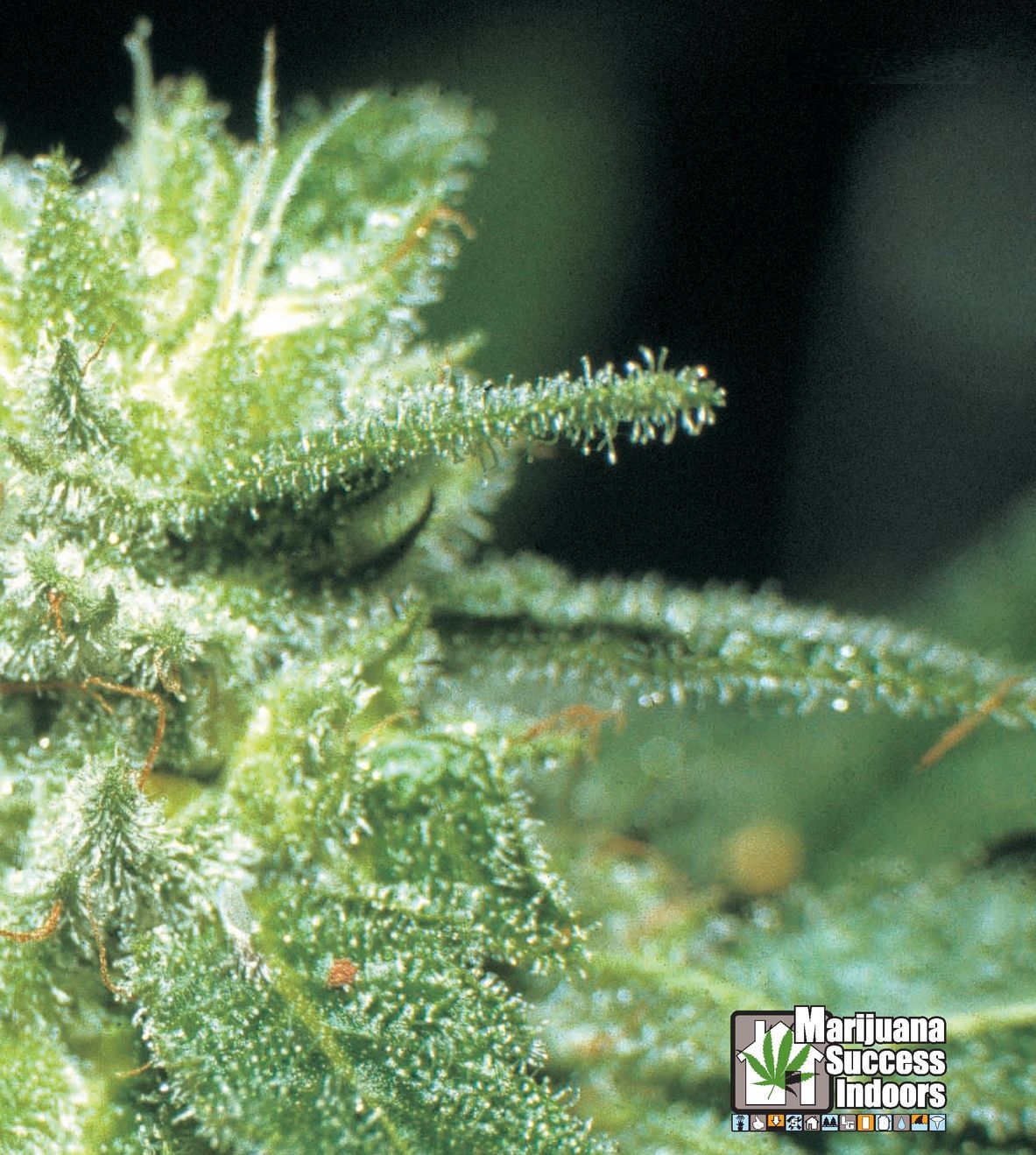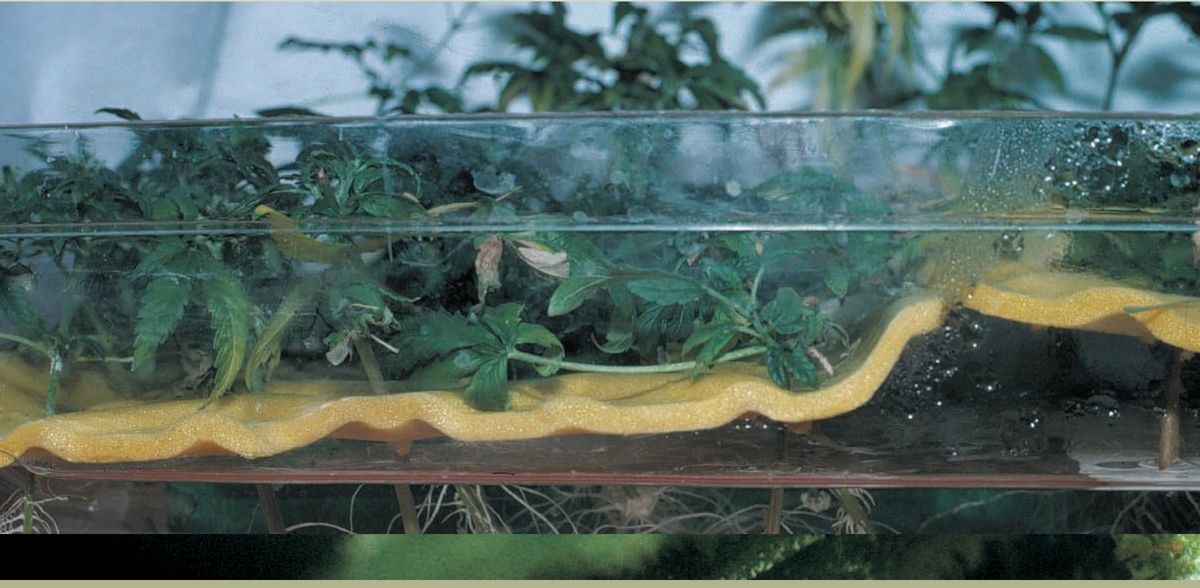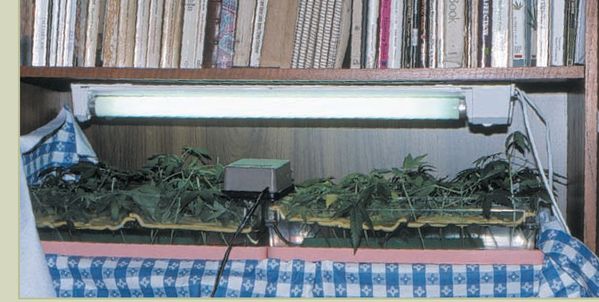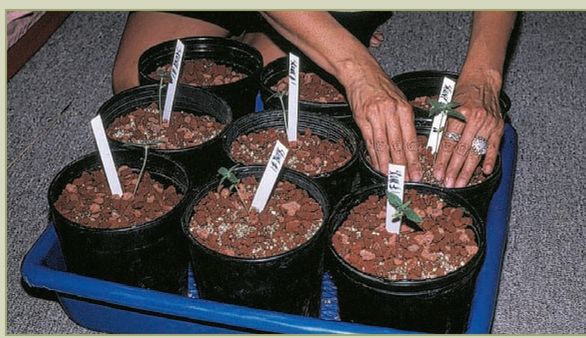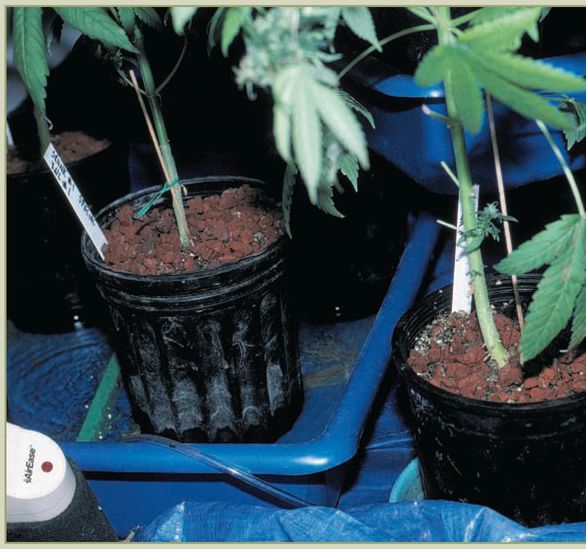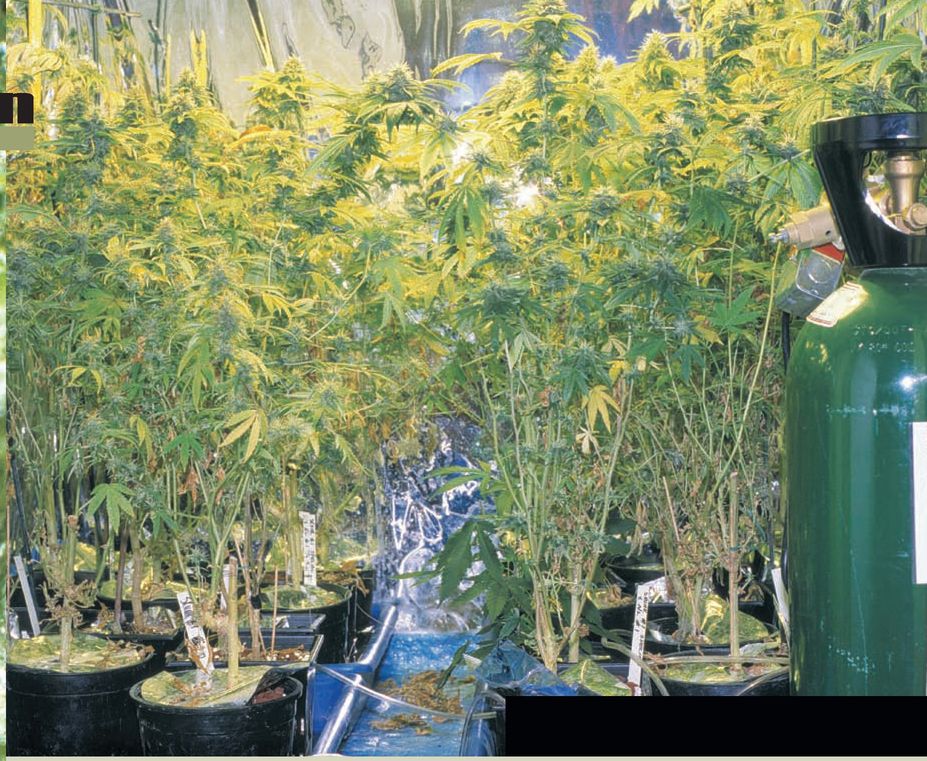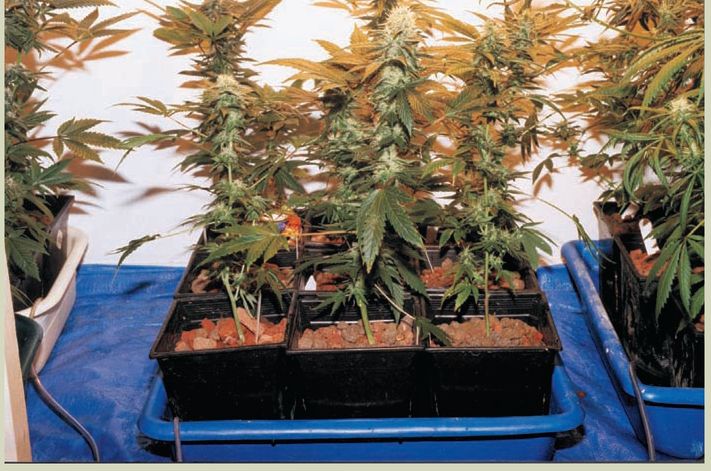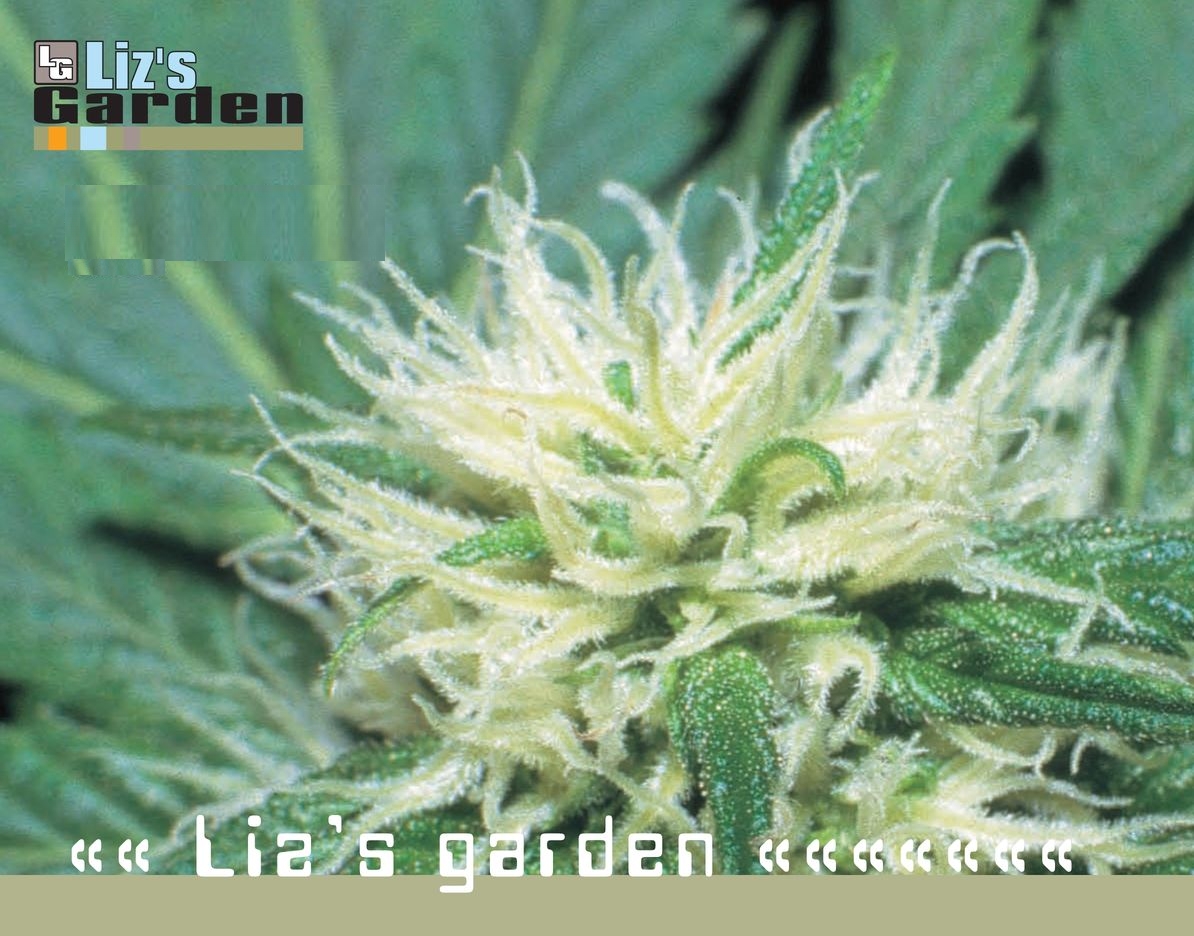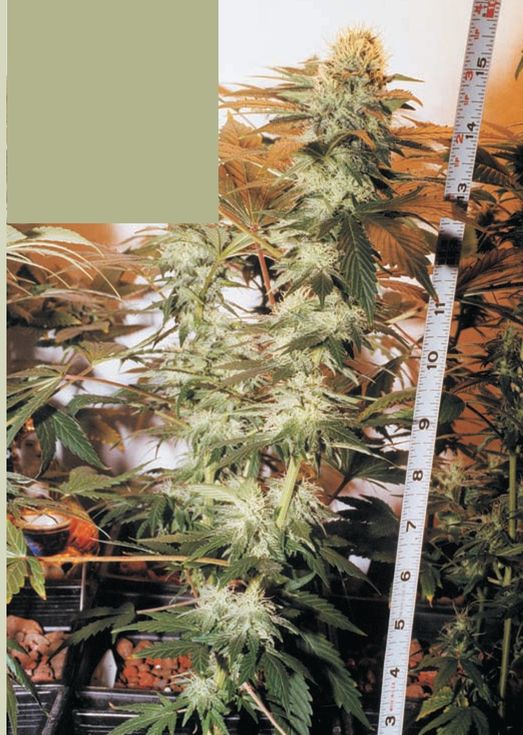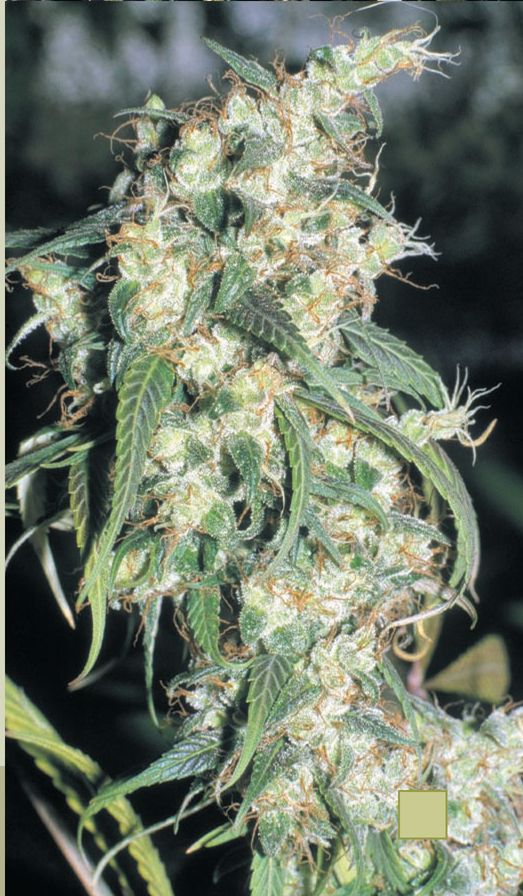Liz’s Garden
This bud is ready to be cut.
Liz started a garden to keep herself supplied with primo buds. She wanted an efficient lowmaintenance system that would produce high quality buds without much effort. She didn’t have a lot of space to spare, so she emptied a closet and prepared it for a garden. She painted the 4’ x 4’ x 7’ closet with flat white bathroom paint containing a fungicide. Then she laid a heavy plastic tarp on the floor to prevent water spillage.
She hung a 400-watt high pressure sodium (HPS) lamp from the ceiling with a chain so its height was adjustable. With pliers she closed one end of a large S-hook around the chain attached to each end of the light. The other end of the S-hook was also attached to the chain so that it was easy to move as the plants grew.
A 20-pound CO2 tank and short interval timer were placed in the chamber. A hole was made in the wall to vent an exhaust fan connected to a thermostat-humidistat. This was set to turn on the fan when the temperature rose to 75°F and the humidity rose to 60 percent. An oscillating fan kept the air circulating in the room at all times.
Liz told me that it took her less than three hours to prepare the space once she removed the debris. “In fact, I took most of the stuff to my friend’s garage sale and paid for the lamp and tarp from the proceeds. My total cost for the light was about $300, the tarp was about $6. The CO2 unit, consisting of a tank, pressure regulator, flow meter, solenoid switch and short cycle timer cost about $500. For $800, what I was paying for two ounces of grass, I was ready to become independent.
“Now it was time to start the seeds. I bought some small rockwool cubes at a local indoor garden shop, placed them in a tray and watered them with a dilute solution of hydroponic vegetative growth stage fertilizer. Then I drained the tray so only a 1/4 inch of water remained.
“I poked a seed 3/8 of an inch into each cube and pushed in a plastic stake. I placed a piece of plastic wrap around the tray to keep the cubes moist so the germinating seeds would find it comfy. The seeds were direct descendants of several varieties of Dutch seed. They all had some skunk in them but were hybrids. They germinated in a few days and were ready for transplanting nine days later.
“I transplanted the seeds into round 6-inch diameter containers filled with a mixture of 5-parts pebble-sized crushed lava rock and 1-part vermiculite. The vermiculite breaks up, and sort of coats the craggy surfaces of the lava, and helps it absorb moisture.”
The rock absorbs water and transports it, through capillary action, much as a tissue moves water. As the roots draw water from the rocks, more is transported upwards. The rocks stay moist without any human effort. To make the mixture, moisten the vermiculite in the bag so there is no dust. It contains a small amount of asbestos so be careful. Using gloves to protect your skin from the lava’s rough surfaces, mix the lava and vermiculite in a basin.
Liz continued, “I placed six containers in each 2’ x 2’ x 5”-high tray and positioned an aerator attached to tubing to the bottom of each of the five trays. Each aerator was attached to a gang valve that was connected to a medium capacity aquarium air pump.” Aerators will float if they are not secured to the bottom of the tray so remember, before setting up, to attach the aerator to the bottom of the tray using silicon glue.
“To start, I watered the containers from the top with a full-strength vegetative growth-stage nutrient/water solution from Genesis. I filled each tray with two to three inches of nutrient/water solution for the lava to draw up, much like a wick. When the water level dropped, I simply added tap water.
Cuttings were placed in water and held in place with a sheet of foam plastic. The water was kept at 72°F using a small aquarium heater.
“After two weeks, I drained the trays and ran unfertilized water through the containers. It was easy to do and not messy at all. In the bathtub I used the flexible showerhead to rinse the lava with 75°F water. Rinsing the containers with plain water washes away mineral salts from the fertilizer, which have crystallized on the lava rocks. It also removes plant residues, as well as natural hormones and enzymes that have built up in the water.
“After the containers were rinsed and drained I placed them back in the trays and watered them from the top with a fresh nutrient/ water solution. When the water started to drain, which happened almost immediately, I filled the trays two inches deep with the same solution.”
Liz finally had a chance to set up the CO2 unit. The unit was the simplest kind controlled by a repeating timer. Every fifteen minutes it injected a burst of CO2 into the room, which she calculated would bring the amount in the space from 200 parts per million (ppm) to 1200 ppm. The total area of the space (height x width x length) multiplied by .01 equals the amount of gas required to increase the ppm to 1200. Her space, 144 cubic feet (4’ x 4’ x 9’) multiplied by .01, required 1.44 cubic feet of gas. The regulator was set to release gas at the rate of 1 cubic foot per second so she set her repeating timer to 1 1/2 seconds every 15 minutes.
Liz changed the fertilizer solution in the trays two weeks after starting. She kept the light about 18 inches above the plants and maintained the water level in the trays at about two inches. During the month, she was away from the garden for a three- or four-day stretch. “The water level in the trays had dropped a bit when I returned, but the plants were still healthy and doing fine. As soon as I got home I added water.” Liz was a good caretaker – the plants were growing quickly, looked vigorous and showed no signs of deficiencies.
“I couldn’t believe it. In 30 days the plants had grown from seedlings to 18-inch plants. This is the size I expected them to be but it is just so amazing to watch them grow. They started out slowly but at the end they were growing more than an inch a day. The books recommended that I switch the light back after 30 days so I did this right on schedule. Since marijuana doesn’t use CO2 at night I plugged the CO2 timer into the light timer so that the unit wouldn’t release CO2 when the lights were off. I also rinsed the pots out as I did a few weeks ago. However, this time I collected the water from the trays and put it in a big bucket.
“The most inconvenient chore is emptying the water from the trays. I scoop some of it out using a flat vase, then I pick up the tray and pour the water into a household cleaning bucket. Friends tell me to get a small water pump, but I haven’t gotten around to it yet. After I dumped the fertilizer water down the drain the first time, my ecological friend Jenny told me that I was polluting the water table with nutrients, which encourage algae blooms and other problems. So now I used it for my houseplants and to fertilize plants in my backyard. Re-use is the first part of recycling. Besides, my other plants have really perked up since I started watering them with the collected water diluted 50-50 with plain water.”
The clone center was placed on a bookshelf.
The first crop: Seedlings are planted in pea-sized lava in 6-inch containers. They are placed in 1 1/2’ x 1 1/2’ trays.
The trays are kept filled with three inches of water/nutrient solution. An air pump and aerator keep the water circulating and oxygenated. Plant roots grow into the water.
Trays with maturing indica-sativa hybrids. A CO2 unit injects the gas into air on a periodic basis.
Liz’s garden was in mid-flower. The buds were swelling and creating their characteristic definition. The Early Pearl and Northern Lights buds grew along main branches, developing their configurations, and then swelling out. The Skunks were maturing more slowly, their buds growing large on the primary branches.
The plants continued to look healthy and had stopped all vegetative growth but were still growing fast and vigorously. All of their efforts were now concentrated on the flowers. The system continued to work without a hitch. Liz added water to the trays as needed to keep a level of about two inches. The fertilizer solution was also changed in each tray every two weeks.
Liz changed over to a flowering fertilizer when she turned the lights down to 12 hours. Flowering formulas supply less nitrogen (N) than vegetative growth mixtures. Instead, the phosphorous (P) and potassium (K) levels are increased to promote more flower growth. Still, the plants showed no signs of lacking nitrogen.
Liz led a busy life in the city. Aside from a heavy work schedule, friends and classes were keeping her busy. This created scheduling problems in the garden. She was unable to take cuttings from the plants until two weeks after turning the lights down. Her life was so hectic at the time that once she took the cuttings she didn’t have time to work on them. So she placed them in the refrigerator for a few days until she had a bit of free time.
The buds were swelling and creating their characteristic definition. The Early Pearl and Northern Lights buds grew along main branches, developing their configurations, and then swelling out. The Skunks were maturing more slowly, their buds growing large on the primary branches.
From the bottom up, her cloning kit consisted of a small heating mat (sold in nurseries) over the wooden bookshelf; a plastic tray about three inches deep, filled with water; an aerator sitting at the bottom of the tray hooked to a pump; and an almost flat Styrofoam plate salvaged from a fruit carton. The plastic tray had melted into the mat a little, so it was replaced with a glass tray.
The clones were cut from the bottom of the plants and trimmed them to about 2 1/2 to 3 inches, leaving only a few leaves at the top. She punched holes into a piece of Styrofoam and inserted the cuttings. The Styrofoam held the clones in place. The water/nutrient solution contained Olivia’s Rooting Solution and flowerfertilizer at 1/4-strength. The heating mat kept the water in the tray in the low to mid-70s(°F). The aerator ensured adequate supplies of oxygen to the stems. The flowering fertilizer was used to limit leaf growth and help stimulate root growth.
Another crop growing indicas in the front and indica-sativa hybrids in the rear. This garden was forced to flower when the plants were only 10 inches tall.
Ninety days after Liz transplanted the seedlings to 6-inch pots, half the garden had been harvested. The Early Pearls and some of the Northern Lights had blossomed, ripened and been cut. Only the Northern Light hybrids, Skunks and hash plant were left. The hash plant had a hard time flowering. It probably would have done better with a longer dark period. A regimen of 13 hours darkness and 11 hours light might have solved its ambivalence about flowering.
New pistil growth had stopped weeks ago. The fan leaves were yellowing and dying, leaving the maturing buds naked. The glands on the remaining plants were filled with resin. When the light was on, the buds sparkled with the twinkle dust of the fluorescing glands. The garden looked bejewelled.
This was Liz’s first time out and she grew a garden of succulent, smelly, sticky, high-potency buds. The tray-and-pot system had worked extremely well. She said, “I didn’t believe that it could be this easy to grow. It was kind of exciting watching the plants grow and mature but seeing these buds - it’s incredible.”
Then she recited the basic steps to her simple reservoir garden. “Put the rocks in the trays three-quarters full, place the rooted clone or seedling in, fill the container with the lava rocks. Place the container in a five- to six-inch deep tray. Fill the tray two inches deep with nutrient/water mix using hydroponic grow formula fertilizer. Change the water every two weeks and add plain water as needed to keep the level at two inches. It’s so easy.”
Young bud shows vigorous growth.
Fresh stigmas of the female flower search the air for pollen. Pollenless, the plant continues to produce new flowers, forming dense colas.
The five-parts-lava-one-part-vermiculite mix stays moist through capillary action, but has large airspaces so the roots always have enough oxygen. The water itself is aerated with a small fish-tank air pump. Roots have been growing out of the containers into the water trays. They look healthy and white.
The clones, which were started two weeks after Liz forced flowering by cutting the constant light to a cycle of 12 on and 12 off, had reverted back to vegetative growth under continuous fluorescent light. They were rooted and ready to be transplanted into the garden. They have been growing slowly in a tray filled with diluted nutrient/water solution. At first Liz used a plant mat placed under the tray to keep the water at 75°F. She didn’t think the mat was doing a great job, so she used a fish tank heater with a built-in thermostat instead.
Liz has harvested all of the plants in the garden, yielding between 6 and 8 ounces. She liked most of the plants especially the NL-Skunk crosses. Shortly after the first harvest Liz renovated her garden. This time she created three growing areas. Her largest space was the 4’ x 4’ flower room. She raised this garden up a bit and built a small vegetative growth space that could handle either clones or plants less than 8 inches tall. It was lit using fluorescent lights. This space was not intended for constant use.
The clones taken early in flowering and kept in the weak nutrient solution under lights were potted and placed in the flowering space. They were kept under constant light but took only three weeks to reach ten inches. This was Liz’s second crop. She decided to save some of her favorite plants using regeneration. First, the buds were picked from the plants, and only leaves were left on a stem no higher than twelve inches. The plants were expected to revert to the vegetative cycle and could then be reflowered. Eighteen days after refilling the garden with clones and regenerates, the lighting cycle was cut back to the flowering cycle of 12 on and12 off. The second crop was starting to flower.
Just before she cut the plants back Liz trimmed off some of the lower branches. This gave her plenty of clones of her favorite plants. She placed the cuttings in her floating clone chamber. After three weeks they were transferred to the stage-two garden and planted into 6-inch containers. Since then cuttings have been taken off these plants and placed in the cutting chamber. For the first time all three of Liz’s gardens are being used. The rooting section, the stage two vegetative growth section and the flowering section all have healthy plants ready to grow up or grow ripe.
Liz was a good caretaker. The plants were growing quickly, looked vigorous and showed no signs of deficiencies.
During the Christmas season Liz discovered “water fountains” which were sold as automatic Christmas tree watering units. They maintain a water level by automatically distributing water when the level sinks. The reservoirs are designed to keep the water level at two inches. The water is stored in a 2-liter (approximately 2 quarts) plastic soda bottle and travels through a small tube directly into the tray. The water level can be adjusted by raising the water fountain unit.
Liz proved that you don’t need an expensive growing system to produce high quality marijuana. She designed the system, renovated the closet and grew the first crop from seed in about 100 days. Her second crop, from hardened clones and regenerates, took about 85 days.
After two more crops Liz changed over to a 1000-watt lamp. This increased production linearly from seven ounces to about 16 ounces of prime bud per crop. Heat build-up was the only problem she had with using the additional power. She solved this by using a more powerful fan.
There are several things Liz could have done to fine-tune her garden, which was already very successful. The first is to have changed the CO2 regulator to a unit that measures CO2 concentration continually and automatically maintains the desired CO2 level. With this unit, CO2 levels would have been maintained more accurately, resulting in more growth.
She could have installed an air-cooled reflector for the 400-watt and especially for the 1000-watt high pressure sodium lamp. The reflectors have a glass plate at the bottom of the reflector. Air from outside the space is drawn through a tube by a fan and is pushed past the bulb, where it is heated. A tube on the other side of the reflector draws the air out where it is released outside the space. The air in the room never gets heated, so it does not need as much ventilation.
Luckily in the city where Liz lived, the fertilizer and water pH combination achieved a perfect pH range for the plants, between 6.1 and 6.5, slightly acidic. In this range the nutrients stay in solution and are available to the plants. Outside this range, the nutrients precipitate and are unavailable to the plants. It is easy to measure using a pH meter or pH test strips. To adjust the pH, use pH Up or pH Down, found in indoor garden shops.

This indica plant was only 13 inches tall. The plant will mature in about two weeks but its vertical growth has stopped. Instead, all its energy goes into flowering.
A sativa-indica hybrid just days away from perfect ripeness.


